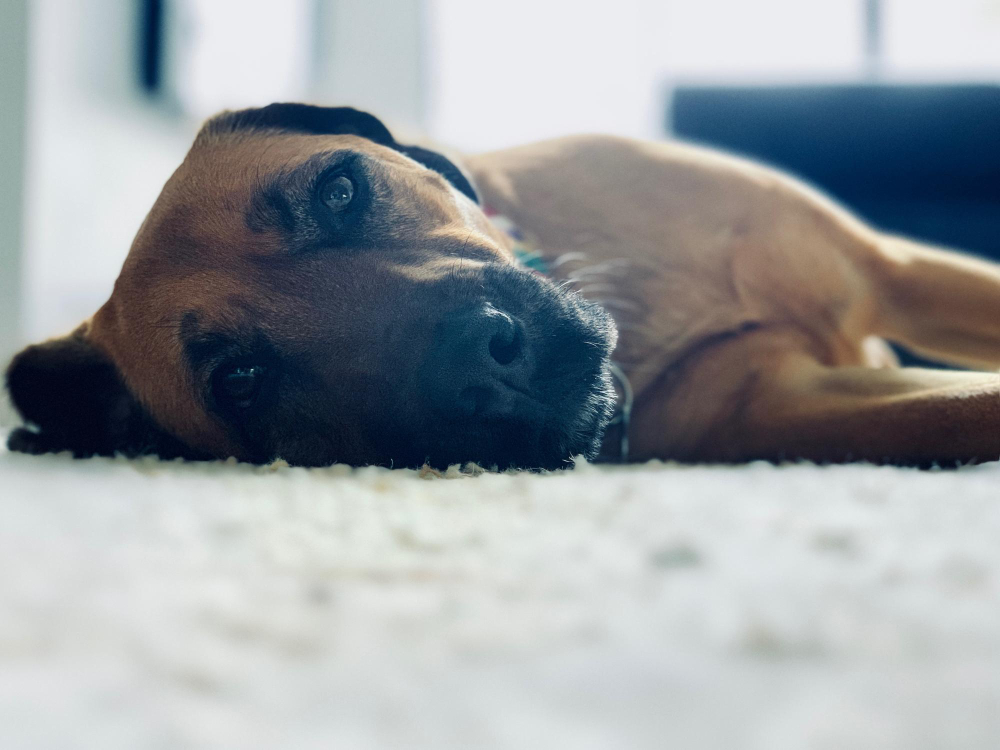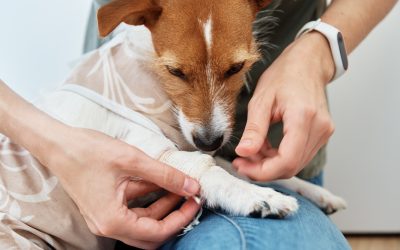How Long Does the Rabies Vaccine Last for Dogs?

Updated October 13, 2025
Rabies is a severe illness that affects the nervous system and can be transmitted through the bite of an infected animal. The rabies vaccine can prevent it, but it’s important to know how long that protection lasts and when booster shots are needed to keep your dog’s immunity up to date.
This guide will explain the details of the rabies vaccine, including how long it typically lasts, factors that can influence its effectiveness, and what you should do to ensure your dog stays protected.
How Do Dogs Get Rabies
The most common source of rabies infection is wildlife reservoirs. Wild animals like bats, raccoons, skunks, and foxes can carry and transmit the rabies virus. Dogs that come into contact with these infected animals, either through direct encounters or by consuming their carcasses, are at risk of contracting the disease.
Bites
Rabies can be transmitted to a dog through the saliva of infected animals. If a wild animal like a bat, raccoon, skunk, or fox bites a dog, the virus can enter the dog’s bloodstream through the wound.
Open Wounds or Mucous Membranes
If an infected animal’s saliva comes into contact with a dog’s open wound or mucous membranes (such as the eyes, nose, or mouth), it can also transmit rabies. This means that even licking an infected carcass, such as a dead skunk, could potentially transmit the virus if the saliva comes into contact with a vulnerable part of the dog’s body.
Indirect Contact (Unlikely)
Transmission through indirect contact, such as a dog licking a dead skunk, is less likely but theoretically possible. The rabies virus is fragile and doesn’t survive long outside the host, so it’s less likely to be transmitted through surfaces or through licking unless fresh saliva from the infected animal enters the dog’s body through an open wound or mucous membranes.
Signs and Symptoms of Rabies in Dogs
Rabies progresses through several stages, and the signs can vary depending on the stage of the disease:
- Prodromal Stage (1-3 Days):
- Behavioral changes: Dogs may become anxious, agitated, or unusually affectionate.
- Fever, lethargy, or general discomfort.
- Some dogs may show signs of nervousness or irritability.
- Excitative (Furious) Stage:
- Aggressive behavior: Dogs may become highly aggressive, snapping, biting, or attacking objects, other animals, or people.
- Restlessness, disorientation, and hyperactivity.
- Dogs may have difficulty swallowing, which can cause foaming at the mouth.
- Seizures and paralysis can occur.
- Paralytic (Dumb) Stage:
- Muscle paralysis, particularly in the face, throat, and jaw (leading to difficulty swallowing and drooling).
- Weakness, lethargy, and eventual paralysis of the limbs.
- Coma, followed by death, typically within a few days after the onset of symptoms.
Understanding The Rabies Vaccine For Dogs
The rabies vaccine is a crucial preventive measure against this deadly disease. It stimulates the dog’s immune system to produce antibodies against the rabies virus. These antibodies can neutralize the virus and prevent it from causing an infection.
Veterinarians usually give the rabies vaccine in a series of shots. The first dose is given as early as three months of age. Subsequent booster shots are required to maintain the dog’s immunity over time.
It works if given correctly and on schedule. However, it is important to note that no vaccine is 100% effective, and there are factors that can influence its effectiveness.
Key Factors That Can Affect the Vaccine’s Efficacy
1. Age of the Dog
- Young Puppies: The maternal antibodies passed from a mother dog to her puppies can interfere with the effectiveness of the initial rabies vaccine if given too early. These antibodies protect the puppy during the early weeks but can neutralize the vaccine, preventing the puppy’s immune system from responding fully.
- Older Dogs: In older dogs, a weakened immune system due to age may reduce the vaccine’s effectiveness.
2. Health Status
- Underlying Health Conditions: Dogs with compromised immune systems due to chronic illness, malnutrition, or certain diseases may not respond as robustly to the rabies vaccine.
- Concurrent Infections: If a dog is already sick or battling another infection, its immune system may not respond effectively to the vaccine.
3. Timing and Schedule Adherence
- Booster Shots: Rabies immunity requires timely booster vaccinations to maintain protection. If boosters are delayed or skipped, immunity can wane, leaving the dog vulnerable.
- Missed Doses: Missing a scheduled vaccination or booster can result in insufficient immunity.
4. Vaccine Storage and Handling
- Improper Storage: Vaccines must be stored and handled according to specific temperature requirements. If a rabies vaccine is stored improperly (e.g., exposed to extreme heat or cold), it can lose its potency and become less effective.
- Expiration: Using an expired vaccine can lead to reduced effectiveness or a lack of immunity.
5. Vaccine Quality and Type
- Vaccine Brand: Not all rabies vaccines are created equal. Some vaccines may have slightly different formulations or qualities. Licensed and well-established vaccine brands are typically very effective, but low-quality or improperly manufactured vaccines can be less reliable.
- Type of Vaccine: Modified-live vaccines and killed vaccines differ in how they stimulate the immune system. The type used may influence the strength of the immune response.
6. Immune Response Variability
- Genetic Factors: Some dogs may have genetic differences that cause them to respond differently to vaccines. While this is rare, certain breeds or individual dogs may have an atypical immune response.
- Previous Exposure: Dogs previously exposed to rabies or similar viruses might react differently to the vaccine. Past exposure can enhance the immune response in some cases, while in others, it might complicate the response.
7. Environmental Factors
- Exposure Risk: Dogs regularly exposed to high-risk environments (e.g., areas with a large wildlife population carrying rabies) may have a higher chance of contracting the virus if their vaccination schedule isn’t properly followed.
- Stress: High stress levels in dogs (due to environment, travel, etc.) can weaken the immune system and potentially reduce the vaccine’s effectiveness.
8. Vaccination Site
- Injection Site Issues: If the vaccine is not administered correctly, such as being given in the wrong part of the body or if the dog’s body fails to absorb it properly, the immune response could be weaker.
How Long Does The Rabies Vaccine Last For Dogs?
The duration of protection provided by the rabies vaccine can vary depending on several factors. Generally, the vaccine is considered effective for one to three years, after which a booster shot is recommended.
Many veterinary groups recommend annual or triennial (every three years) booster shots for dogs. This depends on the vaccine used and local laws. These groups include the American Animal Hospital Association (AAHA) and the American Veterinary Medical Association (AVMA).
The AAHA (American Animal Hospital Association) and AVMA (American Veterinary Medical Association) push for dog vaccinations because they protect pets and people. Here’s why:
- Preventing Disease: Vaccines protect dogs from deadly diseases like rabies, distemper, and parvo. Vaccinating your dog ensures that your dog doesn’t suffer from preventable diseases.
- Public Safety: Rabies is a big concern because it can spread to humans. Vaccinating dogs against rabies helps protect not just pets but people, too, which is why it’s often a legal requirement.
- Herd Immunity: When enough dogs are vaccinated, it helps stop the spread of diseases, even to those dogs who might not be able to get vaccinated. It’s like a safety net for the whole dog community.
- Legal Requirements: Laws often require rabies shots to prevent outbreaks and keep the public safe. Groups like AAHA and AVMA support these laws because they help keep rabies under control.
The average cost of a rabies vaccine for dogs is $40-75 per shot.
How Quickly Does Rabies Develop in Dogs?
The incubation period for rabies in dogs can vary widely, ranging from a few days to several months. The average incubation period is typically between two and eight weeks. Still, the duration can vary depending on factors such as the location of the bite, viral load, and the dog’s immune response.
During incubation, the dog may not show any signs of illness. However, symptoms will begin to appear as the virus spreads and reaches the brain.
Once clinical signs of rabies appear, the disease is almost always fatal in dogs. Therefore, seeking prompt medical attention and following recommended protocols for post-exposure prophylaxis is recommended if your dog has been bitten or exposed to a potentially rabid animal.
What To Do If A Vaccinated Dog Is Bitten By A Potentially Rabid Animal
If your vaccinated dog is bitten or exposed to a potentially rabid animal, here are the steps you should follow:
- Seek veterinary attention: Contact your veterinarian immediately and inform them about the bite or exposure. They will provide guidance on the necessary steps, including booster vaccinations or post-exposure prophylaxis.
- Quarantine and observation: Your veterinarian may recommend quarantining and closely observing your dog for signs of rabies for a specified period, typically ten days to several months, depending on the circumstances.
- Report the incident: Report the bite or exposure to local animal control authorities, as they may need to investigate the potential rabies source and take appropriate measures.
- Follow veterinary instructions: Follow your veterinarian’s instructions regarding any additional vaccinations, medications, or monitoring required for your dog’s safety and preventing potential rabies transmission.
FAQs
What is rabies, and why is vaccination critical?
Rabies is a fatal viral disease affecting the central nervous system, and is virtually 100% fatal once symptoms appear. No treatment exists after symptoms start, and no test can diagnose living animals. Transmitted through the saliva of infected animals (bites, scratches, contact with eyes/mouth/wounds). Dogs contract it from wildlife (bats, raccoons, skunks, foxes) or by consuming infected carcasses. Symptoms: behavioral changes, fever, difficulty swallowing/foaming, paralysis, seizures, coma, death within days. Vaccination is legally required in most states and is the only protection.
When and how often should dogs be vaccinated?
- First dose: 12-16 weeks (3-4 months) of age—not before 3 months as immune response is weaker in young animals.
- First booster: 1 year later (15-16 months of age).
- Subsequent boosters: Every 3 years in most states, or annually if state law requires.
- Duration: First shot good for 1 year, subsequent shots for 3 years legally (though medical immunity may last 6.5+ years). State law determines requirements—consult your vet.
How effective is the rabies vaccine, and what affects it?
Highly effective when given correctly and on schedule.
Factors affecting effectiveness: Young puppies (maternal antibodies interfere if given too early), older dogs (weakened immune system), compromised health/chronic illness, concurrent infections, delayed/skipped boosters, high stress, and incorrect administration. Research shows vaccinated dogs may retain protective immune memory 6.5+ years, with some mounting protective responses up to 8 years later. Titer testing measures antibody levels but can’t legally replace vaccination.
What happens if my dog’s vaccine is overdue or if my dog has been exposed to rabies?
- Overdue (legal issue): Dog considered legally unvaccinated even if days late.
- Exposure: Contact vet immediately, report bite to animal control, boost vaccine promptly, observe/quarantine. Unvaccinated exposed dogs should be euthanized or face a strict 4-month quarantine. Vaccinated exposed dogs need a booster and shorter observation (typically 45 days).
Is the rabies vaccine safe and what are side effects?
The rabies vaccine is generally safe and the best protection against a deadly disease.
- Common (mild): Discomfort/swelling at injection site, slight fever, decreased appetite/activity (1-2 days).
- Contact vet if: Side effects persist beyond few days, swelling lasts 3+ weeks or grows.
- Emergency (rare): Facial swelling, hives, difficulty breathing, collapse, anaphylaxis—requires immediate care. Over-vaccination exposes dogs to unnecessary risks and adverse reactions, so vaccinate only as needed.
Does pet insurance cover rabies vaccination and what are legal requirements?
Odie’s Wellness Plan covers routine rabies vaccines (up to $700/year reimbursement, including Petivity devices/Purina products). The Illness & Injury Plan covers emergency treatment if the dog contracts rabies or needs care after exposure. Cost: $20-$50 per vaccine.
Lega Requirements: Vaccination required by law in most states—face civil penalties/quarantine if not complied. Need proof for boarding, daycare, grooming, training, and travel (especially international). Dogs cannot travel without a current, valid vaccine. Even indoor dogs need vaccination, it’s legally required and protects against unexpected exposure.




